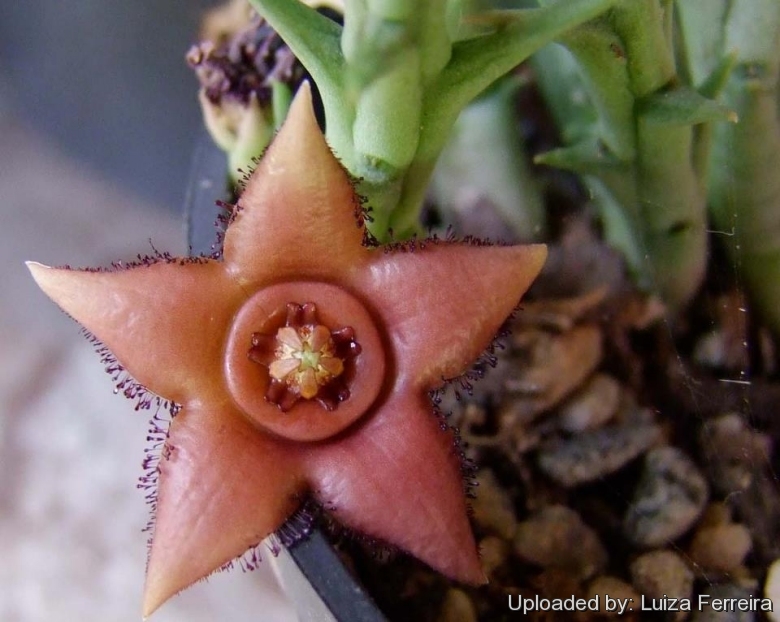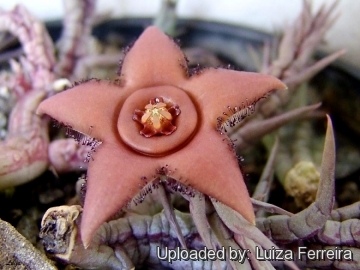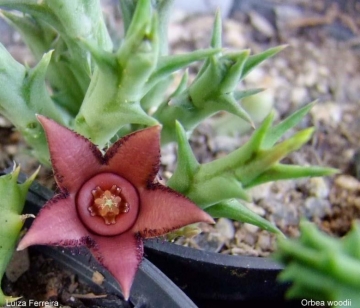
Orbea woodii Photo by: Luiza Ferreira
Origin and Habitat: Orbea woodiiSN|30457]]SN|30457]] is only known from central KwaZulu-Natal (South Africa) along the middle reaches of the Tugela River Valley. Extent of occurrence less than 5000 km² known from less than 10 locations.
Altitude range: 800-1200 metres above sea level.
Habitat and Ecology: Valley thicket and savanna, open and closed dry woodland. Plants are usually found on gently sloping areas of shale with dolerite rocks, between stones and small tufts of grass, Aloe, and other smaller succulents, and seem generally to be rare and scattered in their occurrence. It is locally collected for medicinal purposes which is causing a continuing decline to the population.
Synonyms:
See all synonyms of Orbea woodii
back
Accepted name in llifle Database:Orbea woodii (N.E.Br.) L.C.LeachKirkia 10(1): 290 1975Synonymy: 3
back
Description: Orbea woodiiSN|30457]]SN|30457]] is a fleshy-stemmed, perennial succulent member of the Asclepiadaceae family that with this morphology form a group collectively known as the stapeliads. It is a small species rarely exceeding 6 cm in height. The flowers appears in clusters of 1-3on the young stems and are up to 4.5 cm in diameter, chocolate or dull purple-brown, sometime with a few dull yellow dots, with dark purple club-shaped vibratile cilia. O. woodii is also easily recognizable vegetatively on account of its narrowly conical very acute teeth along the stems. The species is variable but does not warrant infraspecific taxa.
Stems: Erect from a shortly decumbent base, 4-7.5 cm long, 6-8(-10) mm across excluding teeth, obtusely 4-angled, with ascending-spreading stout narrowly conical very acute teeth 8-12 mm long, with 2 minute lateral teeth, glabrous, green, striped and mottled with purple,.
Flowers: 1-3 (rarely more) together near the base of the young stems, successively developed. Pedicels 25-30mm long, glabrous. Sepals 4-5 mm long, ovate-lanceolate, acuminate, glabrous. Corolla 3-4.5 cm across, inside light reddish brown to dark maroon, often yellow-spotted, wrinkled, minutely downy; limb flat, with prominent convex annulus supporting outer corona raised above the level of the horizontally spreading or slightly deflexed lobes glabrous on both sides, very rugose with small transverse wrinkles on the inner surface. Corolla lobes 10-12 mm long, 8-10 mm broad, ovate, acuminate, acute or shortly acuminate, convex, with recurving margins, chocolate or dull purple-brown, sometime with a few dull yellow dots, with dark purple club-shaped vibratile cilia at least in part along the middle part of the lobes. Outer corona-lobes horizontally spreading, 1.5-2 mm long and nearly as broad, rectangular or subquadrate, notched or subdenticulate at the apex, with raised longitudinal channeldown the face, dark purple-brow. Inner corona-lobes simple c. 2 mm high, with the basal part horizontally incumbent on the backs of the anthers, flattish, ovate-oblong or elliptic-oblong, tapering into an erect subulate point about 1/2 lin. long, entire or with a minute tooth on each side at the base of the point, and slightly produced behind into a minute ascending entire or bifid tubercle, purple-brown, without extended horns or wing.
Fruits: Flies pollinated, the flowers resulting in the typical twin seed horns (follicles), which are decorative in themselves and often don't appear until a year later.
Blooming time: Flowers are freely produced throughout the late summer and autumn.
Bibliography: Major references and further lectures
1) N. E. Brown. “Flora Capensis” Vol 4, 1909
2) John Hunter Thomas “Systematic Botany Monographs” American Society of Plant Taxonomists, 2002
3) Focke Albers, Ulrich Meve “Illustrated Handbook of Succulent Plants: Asclepiadaceae: Asclepiadaceae” Volume 4 Springer Science & Business Media, 2002
4) Doreen Court “Succulent Flora of Southern Africa” CRC Press, 01 June 2000
5) Victor, J.E., Styles, D. & Scott-Shaw, C.R. 2005. Orbea woodii (N.E.Br.) L.C.Leach. National Assessment: Red List of South African Plants version 2014.1. Accessed on 2015/02/09
6) James Cullen, Sabina G. Knees, H. Suzanne Cubey “The European Garden Flora Flowering Plants: A Manual for the Identification of Plants Cultivated in Europe, Both Out-of-Doors and Under Glass” Cambridge University Press, 11 August 2011
7) White & Sloane “The Stapelieae” edn 2 1937
8) “Flowering plants of South Africa: A Magazine Containing Hand-coloured Figures with Descriptions of the Flowering Plants Indigenous to South Africa.” London, Johannesburg and Cape Town 19: 724 (1939)
9) Excelsa Taxonomic Series 1: 38,39 1978
10) Bruyns, P.V. 2002. “Monograph of Orbea and Ballyanthus (Apocynaceae-Asclepiadoideae-Ceropegieae).” Systematic Botany Monographs 63:1-196.
11) Bruyns, P.V. 2005. “Stapeliads of southern Africa and Madagascar.” (Vol. 1, pp. 1-330). Umdaus Press, Pretoria.
12) Peter Vincent Bruyns: “New combinations in the genus Orbea.” In: Aloe, 37 (4): 72-76. 2001.
13) Scott-Shaw, C.R. 1999. "Rare and threatened plants of KwaZulu-Natal and neighbouring regions." KwaZulu-Natal Nature Conservation Service, Pietermaritzburg.
 Orbea woodii Photo by: Luiza Ferreira
Orbea woodii Photo by: Luiza Ferreira Orbea woodii Photo by: Luiza Ferreira
Orbea woodii Photo by: Luiza Ferreira Orbea woodii Photo by: Luiza Ferreira
Orbea woodii Photo by: Luiza FerreiraSend a photo of this plant.The gallery now contains thousands of pictures, however it is possible to do even more. We are, of course, seeking photos of species not yet shown in the gallery but not only that, we are also looking for better pictures than those already present.
Read More... Cultivation and Propagation: Orbea woodiiSN|30457]]SN|30457]] is one of easiest species to grow but prone to root rot due to overwatering and lack of fresh air.
Potting medium: Since roots are quite shallow, use a gritty, very free-draining compost. Extra perlite or pumiceis suitable, and clay pots help the plants to dry out between watering.
Moisture: Water normally in the growing season, sparsely in the winter.
Spring: In the spring leaving them out in the rain may provide them with the water they need.
Summer: In the summer months they will grow well in full sun or partial shade and tolerate heavy rain, but will be just as happy if the season is dry.
Winter: It is usually recommended to over-winter them in warm conditions (at 10° C), but despite their African origins they seem to grow well and flower without the extra heat which one might have thought necessary, and occasional temperatures near 0°C (or less) are tolerated, if kept dry.
Note: Indoors only in brightest position.
Pests & diseases: It is quite resistant to the “Black spot” disease of Asclepiads.
Propagation: Propagation is done mainly from cuttings, but with uncertain results as the severed ends very rarely form a callus from where roots will eventually form.














